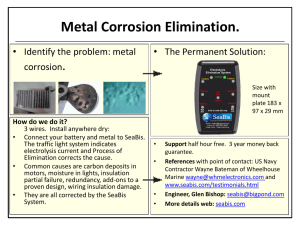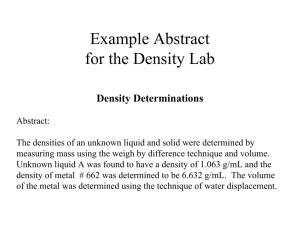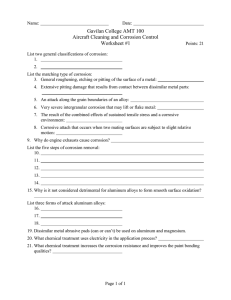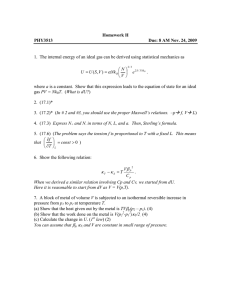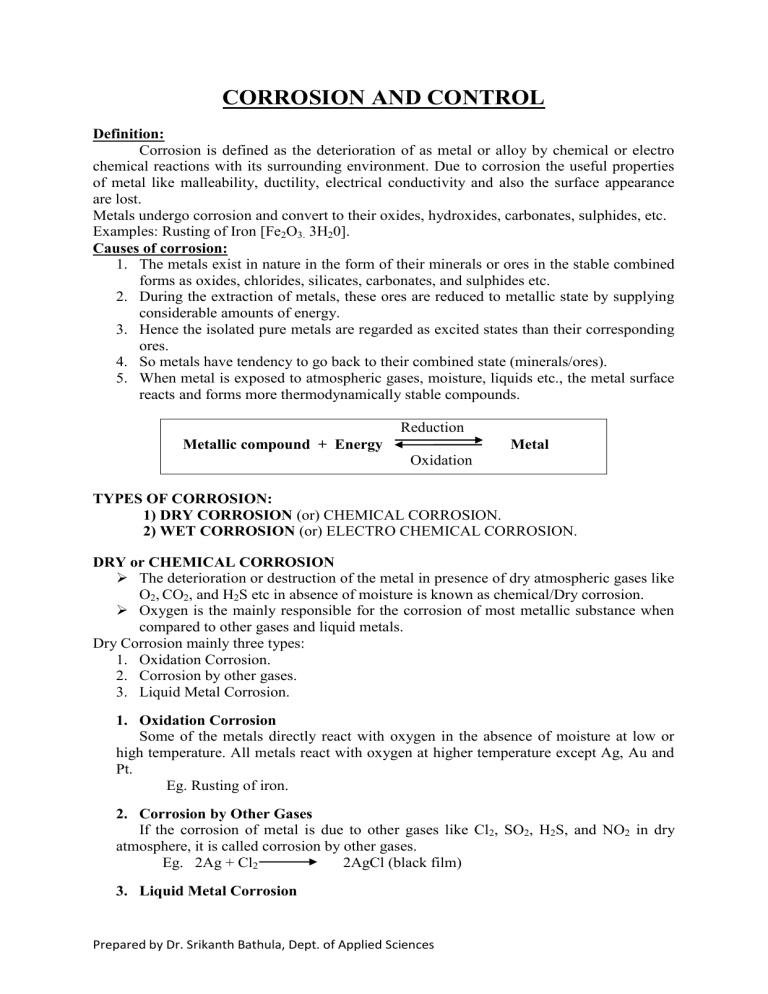
CORROSION AND CONTROL Definition: Corrosion is defined as the deterioration of as metal or alloy by chemical or electro chemical reactions with its surrounding environment. Due to corrosion the useful properties of metal like malleability, ductility, electrical conductivity and also the surface appearance are lost. Metals undergo corrosion and convert to their oxides, hydroxides, carbonates, sulphides, etc. Examples: Rusting of Iron [Fe2O3. 3H20]. Causes of corrosion: 1. The metals exist in nature in the form of their minerals or ores in the stable combined forms as oxides, chlorides, silicates, carbonates, and sulphides etc. 2. During the extraction of metals, these ores are reduced to metallic state by supplying considerable amounts of energy. 3. Hence the isolated pure metals are regarded as excited states than their corresponding ores. 4. So metals have tendency to go back to their combined state (minerals/ores). 5. When metal is exposed to atmospheric gases, moisture, liquids etc., the metal surface reacts and forms more thermodynamically stable compounds. Reduction Metallic compound + Energy Metal Oxidation TYPES OF CORROSION: 1) DRY CORROSION (or) CHEMICAL CORROSION. 2) WET CORROSION (or) ELECTRO CHEMICAL CORROSION. DRY or CHEMICAL CORROSION The deterioration or destruction of the metal in presence of dry atmospheric gases like O2, CO2, and H2S etc in absence of moisture is known as chemical/Dry corrosion. Oxygen is the mainly responsible for the corrosion of most metallic substance when compared to other gases and liquid metals. Dry Corrosion mainly three types: 1. Oxidation Corrosion. 2. Corrosion by other gases. 3. Liquid Metal Corrosion. 1. Oxidation Corrosion Some of the metals directly react with oxygen in the absence of moisture at low or high temperature. All metals react with oxygen at higher temperature except Ag, Au and Pt. Eg. Rusting of iron. 2. Corrosion by Other Gases If the corrosion of metal is due to other gases like Cl2, SO2, H2S, and NO2 in dry atmosphere, it is called corrosion by other gases. Eg. 2Ag + Cl2 2AgCl (black film) 3. Liquid Metal Corrosion Prepared by Dr. Srikanth Bathula, Dept. of Applied Sciences When liquid metal is allowed to flow over solid metal at high temperature. The solid metal is weakened either due to its dissolution into liquid metal into it. Eg. Liquid sodium used as a coolant in nuclear reactors cause the corrosion of cadmium rods. Mechanism of Dry Corrosion In this corrosion, the metal then gets oxidized to metal ions and the electrons are released reduce oxygen to form oxide ion. The metal ion and oxide ion finally combine to form metal oxide (M2On) on the metal surface. Chemical equation: 2M 2Mn+ + 2 ne- (oxidation) nO2 + 2 ne 2n O2(reduction) 2M + nO2 M2O2n (metal oxide) The nature of the metal oxide layer plays an important role in determining further corrosion process. 1. Stable, protective and non-porous oxide: The formation of oxide film on the metal surface acts as physical barrier between the metal and the environment and prevents further corrosion of metal. E.g. Al, Cr, Cu and W. 2. Porous and non-protective oxide film: The formation of a loose, non-homogeneous and porous oxide film permits the oxygen on to metal surface through pores or cracks further corrosion takes place. E.g. Alkali and Alkaline earth metals. Pilling-Bed worth Rule: The protective or non-protective oxide film is determined by the ratio of the volume of metal oxide layer to the volume of the metal consumed. This ratio is known as Pilling-Bedworth ratio. Pilling-Bed worth Ratio = Volume of metal oxide formed Volume of metal consumed According to Pilling-Bed worth rule, If the ratio is less than one the metal oxide layer will be porous and non-protective. E.g. oxide layers of alkali and alkaline earth metals. If the ratio is equal or greater than one then the metal oxide layer will be non-porous and protective. E.g. oxide layers of Al, Cr, Cu, and W. Wet (or) Electro Chemical Corrosion: When the metal is in contact with moisture or solution anode and cathode area will be formed on the metal surface. Prepared by Dr. Srikanth Bathula, Dept. of Applied Sciences The solution or moisture provide electrolytic medium. At anode metal atom undergo oxidation to produce metal ions. The electrons migrate towards the cathode on the metal surface. The reduction reaction takes place at cathode. The corrosion product is formed near cathode. The anode suffers metal loss due to continuous dissolution of metal. Mechanism of Wet Corrosion: This mechanism is explained two ways: 1. Evolution of Hydrogen gas (H2) 2. Absorption of Oxygen (O2). 1. Evolution of Hydrogen gas (H2). In the absence of oxygen and acidic medium metal oxidation takes place at anodic area and evolution of hydrogen gas takes place at Cathodic area. Chemical reaction: Anode: Cathode: Fe2+ + 2e- (oxidation) Fe 2H+ + 2e- H2 Net reaction: Fe + 2H+ (reduction) Fe2+ + H2 1. Absorption of Oxygen (O2). This is type of corrosion takes place in neutral or alkaline medium in the presence of oxygen. The Fe2+ ions produced at anode migrate towards the cathode through moisture and react with OH- to form Fe(OH)2. Further oxidation Fe2O3.H2O is formed. Chemical reaction: Anode: Fe Fe2+ + 2e- (oxidation) Cathode: H2O + O2 + 2e 2OH- (reduction) Net reaction: Fe + H2O + O2 Fe(OH)2 Prepared by Dr. Srikanth Bathula, Dept. of Applied Sciences Differences between Dry and Wet Corrosion: 1. 2. 3. 4. 5. Dry or Chemical corrosion It takes place at dry conditions. It involves direct chemical attack of environment on the metal. It can take place on homo and heterogeneous surfaces. Corrosion product accumulated at the same spot where corrosion has occurred. Uniform corrosion takes place. Wet or Electrochemical corrosion. 1. It takes place in wet condition. 2. It involves the formation of large number of galvanic cells. 3. It can takes place only on heterogeneous surface 4. corrosion product accumulated at cathode where corrosion occurs at anode. 5. Non uniform corrosion takes place. Types of Corrosion TYPES OF WET CORROSION STRESS CORROSION Stress Corrosion is seen in metals suffering from stress which may result from mechanical operations such as design reverting, cold working, welding , bending, pressing, quenching etc. In a corrosive environment the stressed portion acts as anode and undergoes corrosion. The other unstressed part of the metal acts a cathode. Ex: caustic embrittlement in boilers. GALVANIC CORROSION This type of corrosion occurs when two different metals are in contact with each other due to the formation of galvanic cell. The metal having less standard reduction potential value act as anode it undergoes oxidation and liberates electrons, which migrates to cathode. The other metal having high standard reduction potential value acts as cathode and reduction reaction takes place on its surface forming OH- ions. The rate of corrosion depends on potential difference between two metals. Prepared by Dr. Srikanth Bathula, Dept. of Applied Sciences If the difference is more, corrosion occurs faster and vice versa. The anodic metal undergoes corrosion and cathodic metal is unaffected. At anode: M M+ + ne- (oxidation reaction) At cathode: 2H+ + 2e- H2 (reduction reaction) Example: zinc metal in contact with copper metal, brass tap in contact with iron pipe etc. WATER LINE CORROSION (OR) DIFFERENTIAL AERATION CORROSION This type of corrosion occurs when a metal is exposed to different concentration of oxygen. The part of metal which is more exposed to air acts as cathode. The other part of the metal, which is less exposed to air acts as anode and undergoes corrosion. It is differential aeration type of corrosion observed in water storage tanks, ships etc. During water line corrosion, the part of the metal below water line is exposed to less oxygen concentration acts as anode and undergoes corrosion. The other part which is more exposed to atmospheric oxygen acts as cathode. PITTINGCORROSION Pitting corrosion is a localised form of corrosion due to breakdown of a protective layer or dirt on the metal surface. The portion of a metal covered by water or other particles is less aerated and acts as anode. The other portion of metal exposed to more oxygen of the environment acts as a cathode. Corrosion takes place at a portion below dust and a small pit is formed. Then the rate of corrosion increases due to small anodic area and large cathodic area. Prepared by Dr. Srikanth Bathula, Dept. of Applied Sciences Factors which influence the rate of corrosion. FACTORS AFFECTING CORROSION: Important factors affect on the rate of corrosion are: 1. Nature of the metal. 2. Nature of the environment. 1. Nature of the metal: I) Position of metal in galvanic series: When two metals or alloys are in electrical contact in presence of electrolyte, the metal which higher oxidation potential suffers corrosion. The extent of corrosion is determined by the difference in the position of the metals. The greater is difference, the faster and higher is the corrosion. Examples: 1. when iron electrical contact with Cu (or) Sn, iron undergoes corrosion since iron is higher oxidation potential than Cu and Sn. 2. When iron is coupled with Zn, Zinc undergoes corrosion due to zinc is higher oxidation potential than iron. II) Purity of metal: Generally pure metal does not corrodes, impurities are present in a metal anodic part get cored. The extent of corrosion increases with the increasing impurities. III) Surface of metal: A rough surface metal readily corrodes as it collects more dirt and provides more cathode spot for corrosion. A polished surface does not corrode easily. IV) Relative areas of the anodic and cathodic parts: When two dissimilar metals are in contact, the corrosion of the anodic part is directly proportional to the areas of the cathodic and anodic parts. When a larger cathode area and a smaller anode area, severe corrosion is takes place. When a smaller cathode area and a larger anode area less corrosion takes place. 2. Nature of corrosive environment i) Presence of impurities in atmosphere: The impurities like industrial gases and particulate matter, which is responsible for electrical conductivity of the surrounding environment, causes the corrosion of metal. ii) Temperature: Corrosion rate is proportional to temperature. Increase in temperature results in an increase in the conductance of the aqueous medium and rate of corrosion also increases and vice versa. iii) pH: Corrosion rate is more in acidic media than basic media. Low pH increase corrosion rate. iv) Moisture in the atmosphere: Prepared by Dr. Srikanth Bathula, Dept. of Applied Sciences Moisture containing atmosphere acts as an electrolyte and causes electrochemical type of corrosion. CORROSION CONTROL METHODS: 1. Proper selection and Designing of materials: Corrosion is controlled by using Proper selection and Designing of materials. A pure metal should be selected over an impure metal as it is more resistant to corrosion than the latter. Metals occupying lower position in electrochemical series should be preferred over those in higher position. Alloys should be selected over the pure metal. Avoid the galvanic couplings in constructions. Avoid a combination of small anodic and large cathodic areas. 2. Cathodic protection: In this method the metal to be protected is forced to act as cathode and corrosion is controlled. This is two ways a) Sacrificial anodic protection. b) Impressed current method. a) Sacrificial anodic protection: In this method the metal to be protected is connected by a wire to a more anodic or reactive metal. During corrosion more anodic metal gets corroded while the base metal (cathode) is protected. The more active metal used is known as sacrificial anode. This metal replaces time to time by fresh one. The most active metals commonly used Mg and Zn. b) Impressed current method: In this method, the metallic object to be protected is made cathode by connecting it with the negative terminal of the D.C source. The positive terminal is connected to an anode like graphite or platinum. The impressed current nullifies the corrosion current. The electrons flow to the metallic object as a result it act as cathode and is protected. Prepared by Dr. Srikanth Bathula, Dept. of Applied Sciences Application of protective coatings: The coating on the metal surface acts as a physical barrier between the metal and corrosive environment and prevent the corrosion to protect the metal. The protective coating can be of two types: a) Metallic coating b) Organic coating a) Metallic coating: Metallic coatings are produced by coating one metal on the surface of another metal. The metal which is protected is called base metal and the metal which is coated on the surface of the base metal is called coating metal. Metallic coatings broadly classified into two types. 1. Anodic coatings 2. Cathodic coatings 1. Anodic coatings: This type of coatings is produced by coating metal used as anodic metal on the surface of the base metal. Ex: coating of Zn, Al and Cd on Fe are anodic, because their reduction potentials are lower than that of base metal iron. If any pores or breaks in metallic coating, exposing the base metal, a galvanic cell is formed between coating metal and base metal, where the coating metal dissolves anodically and the base metal is protected. 2. Cathodic coating: Cathodic coatings are obtained by coating a more noble metal (higher reduction potential) than the base metal. The coating metal has higher reduction potential than the base metal and protects the base metal due to their higher corrosion resistance than the base metal. Ex: coating of tin (Sn) on the surface of iron. Cathodic coating provides effective protection to the base metal. If any pores or cracks formed in the cathodic coating more corrosion takes place to the base metal, because of small anode and large cathode area. Prepared by Dr. Srikanth Bathula, Dept. of Applied Sciences METHODS OF APPLICATION OF METALLIC COATINGS The following methods are applied of the metallic coating. i) Hot dipping ii) Electroplating iii) Metal cladding iv) Electroless plating i) Hot dipping: In this method, the metal to be coated is dipped in the molten bath of the coating metal for sufficient time and then removed out along with the adhering film. It is used for producing a coating of low melting metal such as Zn, Pb, Al etc., on iron, steel and copper which have relatively higher melting points. a) Galvanising: It is the process of coating iron or steel sheets with a thin coat of zinc to prevent them from rusting. The process is carried out as follows: The iron or steel article is first cleaned by pickling with dilute sulphuric acid solution for 15-20 minutes at 60 - 900C. This treatment also removes any scale, rust and impurities. The article is then washed well and dried. It is then dipped in bath of molten zinc, maintained at 425-4300C. The surface of the bath is kept covered with a flux (NH4Cl) to prevent oxide formation. When the article is taken out, it is found to have been coated with a thin layer of zinc. It is then passed through a pair of hot rollers. This process removes excess of zinc and produces a thin film of uniform thickness. Then it is annealed at a temperature of 6500C and finally cooled slowly. Prepared by Dr. Srikanth Bathula, Dept. of Applied Sciences Galvanising of sheet steel b) Tinning: The process of coating tin over the iron or steel articles. The process is carried out as follows: The process consists in first treating steel sheet in dilute sulphuric acid to remove any oxide film. After this it is passed through a bath of zinc chloride flux. The flux helps the molten metal to adhere to the metal sheet. Next, the sheet passes through a tank of molten tin and finally through a series of rollers from underneath the surface of a layer of palm oil. The palm oil protects the hot tin coated surface against oxidation. The rollers remove any excess of tin and produce a thin film of uniform thickness on the steel sheet. Tinning Of Sheet Steel Electroplating: The process of depositing the coating metal on the surface of the base metal by electrolysis is called electroplating. The base metals are inferior or anodic to the coating metal and electrolyte is the solution containing the metal ions to be deposited on the base metal. The base metal is made cathode and the coating metal is made anode. A direct current is passed the coating metal ions migrate to the cathode and deposit on the base metal article in the form of a thin layer. Prepared by Dr. Srikanth Bathula, Dept. of Applied Sciences Prepared by Dr. Srikanth Bathula, Dept. of Applied Sciences Prepared by Dr. Srikanth Bathula, Dept. of Applied Sciences
